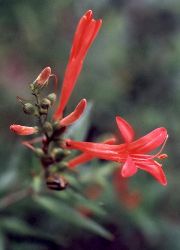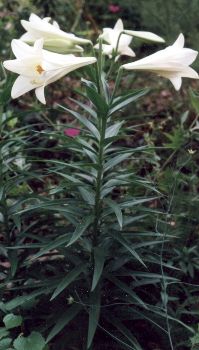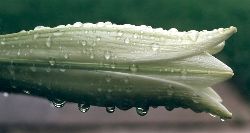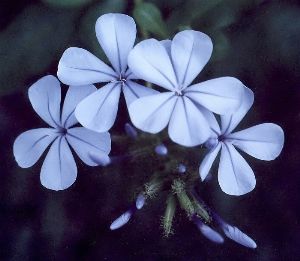|
Three totally unrelated species of plants are our next subjects. It just seemed a patriotic thing to lump them together on the random aspect of color alone. They aren't even all native to this country.
 Representing red, one of our most prolific perennials is the hummingbird bush, or flame acanthus (Anisacanthus wrightii). It is also called butterfly bush, but so are several other unrelated plants. The flowers of this small bush are only about an inch long and range from almost red to light orange. Hummingbirds love them. We have hummingbirds around our yard throughout the growing season and one of the areas that is jealously guarded has a number of these plants. The blooms also attract butterflies and bees. A drought resistant native, the flame acanthus loses its leaves during the winter, but the stiff stems remain and will start sprouting very early in the year. It can get quite large and sprawling unless pruned back every year. It blooms more in the sun, but will even flower in shady areas. A very easy plant to propagate from seed, we started with one small plant and now have them in several areas. There is a slight difficulty in collecting seeds, since when they are ripe, the pods snap open, flinging the seeds away. They must be collected just before they do this, and it is not advisable to leave the whole seed pods in an open container, because as they dry, they will open the same way, throwing seeds everywhere.
Representing red, one of our most prolific perennials is the hummingbird bush, or flame acanthus (Anisacanthus wrightii). It is also called butterfly bush, but so are several other unrelated plants. The flowers of this small bush are only about an inch long and range from almost red to light orange. Hummingbirds love them. We have hummingbirds around our yard throughout the growing season and one of the areas that is jealously guarded has a number of these plants. The blooms also attract butterflies and bees. A drought resistant native, the flame acanthus loses its leaves during the winter, but the stiff stems remain and will start sprouting very early in the year. It can get quite large and sprawling unless pruned back every year. It blooms more in the sun, but will even flower in shady areas. A very easy plant to propagate from seed, we started with one small plant and now have them in several areas. There is a slight difficulty in collecting seeds, since when they are ripe, the pods snap open, flinging the seeds away. They must be collected just before they do this, and it is not advisable to leave the whole seed pods in an open container, because as they dry, they will open the same way, throwing seeds everywhere.

 The Easter lily (Lilium longiflorum), or trumpet lily, is an extremely popular potted plant, and, within that U.S. market, it is the fourth largest crop in wholesale value, following poinsettias, chrysanthemums and azaleas. It also has the shortest marketing window: only two weeks each year. A native of Ryukyu, Japan, the Easter lily is quite adaptable and we have been able to plant the bulbs in our gardens and have them reappear for years, blooming faithfully well after Easter, and after most bulbs have finished blooming and already wilted. The big white flowers are fragrant and attract a lot of insects. By midsummer, the foliage eventually dies back and the plants don't reappear until early spring. We have them in slightly shaded areas that don't get the full heat of the summer sun and also stay a little moister than normal. Eventually, however, the severe summers do seem to take their toll and our oldest plants have become less vigorous.
The Easter lily (Lilium longiflorum), or trumpet lily, is an extremely popular potted plant, and, within that U.S. market, it is the fourth largest crop in wholesale value, following poinsettias, chrysanthemums and azaleas. It also has the shortest marketing window: only two weeks each year. A native of Ryukyu, Japan, the Easter lily is quite adaptable and we have been able to plant the bulbs in our gardens and have them reappear for years, blooming faithfully well after Easter, and after most bulbs have finished blooming and already wilted. The big white flowers are fragrant and attract a lot of insects. By midsummer, the foliage eventually dies back and the plants don't reappear until early spring. We have them in slightly shaded areas that don't get the full heat of the summer sun and also stay a little moister than normal. Eventually, however, the severe summers do seem to take their toll and our oldest plants have become less vigorous.

Blue is represented here by plumbago (Plumbago auriculata). Although the flowers look like phlox, this is a medium, drooping shrub-like perennial that is not related. It is also not native, instead coming from South Africa. Other names include Cape leadwort, Cape plumbago and skyflower. It comes in shades from white to bright blue, but a light blue is most common. The plant freezes back to the ground in winter, but has always come back from the roots in the spring. I have not propagated this plant, and so have just the one that I bought several years ago. It grows quite well in partial shade, next to a large rock. The base of each flower is covered with short green hair-like structures that are very sticky and our dog often comes in with them stuck to various parts of her body where she has brushed against it.
|
 Representing red, one of our most prolific perennials is the hummingbird bush, or flame acanthus (Anisacanthus wrightii). It is also called butterfly bush, but so are several other unrelated plants. The flowers of this small bush are only about an inch long and range from almost red to light orange. Hummingbirds love them. We have hummingbirds around our yard throughout the growing season and one of the areas that is jealously guarded has a number of these plants. The blooms also attract butterflies and bees. A drought resistant native, the flame acanthus loses its leaves during the winter, but the stiff stems remain and will start sprouting very early in the year. It can get quite large and sprawling unless pruned back every year. It blooms more in the sun, but will even flower in shady areas. A very easy plant to propagate from seed, we started with one small plant and now have them in several areas. There is a slight difficulty in collecting seeds, since when they are ripe, the pods snap open, flinging the seeds away. They must be collected just before they do this, and it is not advisable to leave the whole seed pods in an open container, because as they dry, they will open the same way, throwing seeds everywhere.
Representing red, one of our most prolific perennials is the hummingbird bush, or flame acanthus (Anisacanthus wrightii). It is also called butterfly bush, but so are several other unrelated plants. The flowers of this small bush are only about an inch long and range from almost red to light orange. Hummingbirds love them. We have hummingbirds around our yard throughout the growing season and one of the areas that is jealously guarded has a number of these plants. The blooms also attract butterflies and bees. A drought resistant native, the flame acanthus loses its leaves during the winter, but the stiff stems remain and will start sprouting very early in the year. It can get quite large and sprawling unless pruned back every year. It blooms more in the sun, but will even flower in shady areas. A very easy plant to propagate from seed, we started with one small plant and now have them in several areas. There is a slight difficulty in collecting seeds, since when they are ripe, the pods snap open, flinging the seeds away. They must be collected just before they do this, and it is not advisable to leave the whole seed pods in an open container, because as they dry, they will open the same way, throwing seeds everywhere.

 The Easter lily (Lilium longiflorum), or trumpet lily, is an extremely popular potted plant, and, within that U.S. market, it is the fourth largest crop in wholesale value, following poinsettias, chrysanthemums and azaleas. It also has the shortest marketing window: only two weeks each year. A native of Ryukyu, Japan, the Easter lily is quite adaptable and we have been able to plant the bulbs in our gardens and have them reappear for years, blooming faithfully well after Easter, and after most bulbs have finished blooming and already wilted. The big white flowers are fragrant and attract a lot of insects. By midsummer, the foliage eventually dies back and the plants don't reappear until early spring. We have them in slightly shaded areas that don't get the full heat of the summer sun and also stay a little moister than normal. Eventually, however, the severe summers do seem to take their toll and our oldest plants have become less vigorous.
The Easter lily (Lilium longiflorum), or trumpet lily, is an extremely popular potted plant, and, within that U.S. market, it is the fourth largest crop in wholesale value, following poinsettias, chrysanthemums and azaleas. It also has the shortest marketing window: only two weeks each year. A native of Ryukyu, Japan, the Easter lily is quite adaptable and we have been able to plant the bulbs in our gardens and have them reappear for years, blooming faithfully well after Easter, and after most bulbs have finished blooming and already wilted. The big white flowers are fragrant and attract a lot of insects. By midsummer, the foliage eventually dies back and the plants don't reappear until early spring. We have them in slightly shaded areas that don't get the full heat of the summer sun and also stay a little moister than normal. Eventually, however, the severe summers do seem to take their toll and our oldest plants have become less vigorous.
